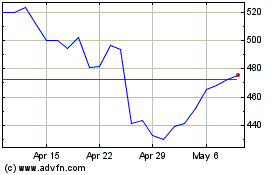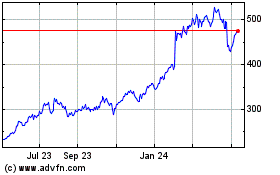Facebook Launches News Analytics Tool in Partnership With Nielsen -- 3rd Update
July 19 2017 - 3:12PM
Dow Jones News
By Lukas I. Alpert
In its continuing efforts to sell publishers on the benefits of
Instant Articles, Facebook is launching a new analytics tool in
partnership with Nielsen that will give news outlets more data on
how their stories perform on the platform.
Facebook also confirmed it is working on a subscription feature
that would allow publishers to charge for access to their articles.
The paywall product, first reported by The Wall Street Journal in
June, will be available through Instant Articles starting in
October. The paywall will likely kick in after a user reads 10
articles in a month, a person familiar with the matter said. The
feature will be tested with a small group of publishers to
start.
Facebook has long argued that stories posted through its
fast-loading Instant Articles program have led to greater
engagement from readers, but some publishers have remained
unconvinced given the lack of specific enough data.
In the past, Facebook has made available performance data
aggregated across the 10,000 or so publishers who have tried the
program. The new tool will now allow publishers to see how their
specific news organizations' stories perform on Instant Articles
collectively, enabling them to compare against those posted using
traditional links sending readers to a mobile webpage.
"This insight provides an important signal publishers can use to
make informed business decisions about how they share content on
Facebook," said Facebook product manager, Mona Sarantakos.
At the beginning, the tool will provide publishers with a very
basic overview of the performance of their own content, but there
are plans to add layers of detail -- such as country-by-country
data -- going forward.
The new data won't, at least for now, provide information on
each individual story posted to Instant Articles.
Kim Lau, vice president of digital and head of business
development at Atlantic Media, which posts almost all its stories
on Facebook using Instant Articles, said the move wasn't
necessarily a game changer, but was a positive sign Facebook was
trying to better accommodate publishers.
"It helps us understand the trade-offs we are making and to
better understand what the benefits are," she said. "We have been
asking for this from the beginning."
Facebook launched the Instant Article program with a handful of
large publishers such as the New York Times, the Daily Mail,
BuzzFeed and NBC News in 2015. It opened it to all publishers the
following year.
But many publishers have been wary about how much content to
post through the program, expressing concerns about becoming more
deeply reliant on Facebook for traffic and having less access to
information about their readers.
Some publishers have also complained that given the limitations
on the number and type of ads initially placed on stories posted on
Instant Articles, they saw less money coming in compared with what
they got through direct visits to their sites. Facebook has since
eased the restrictions, which some say has improved the
situation.
Still, some big publishers, such as the Guardian and the Times,
have pivoted away from the program, and others have reduced the
amount of content they post there.
Others, such as the Daily Mail, which posts almost all of its
content on Facebook via Instant Articles, say there have been clear
benefits, including drawing in more readers.
"It's true that the CPMs have been a little lighter there than
on our own mobile webpage, but we have seen close to 50% uplift, so
if you do the math you can see that added volume outweighs whatever
little bit we may lose on CPM," said Noah Szubski, the Mail's chief
product officer. CPM refers to the cost to an advertiser for
reaching a thousand people.
Write to Lukas I. Alpert at lukas.alpert@wsj.com
(END) Dow Jones Newswires
July 19, 2017 15:57 ET (19:57 GMT)
Copyright (c) 2017 Dow Jones & Company, Inc.
Meta Platforms (NASDAQ:META)
Historical Stock Chart
From Mar 2024 to Apr 2024

Meta Platforms (NASDAQ:META)
Historical Stock Chart
From Apr 2023 to Apr 2024
